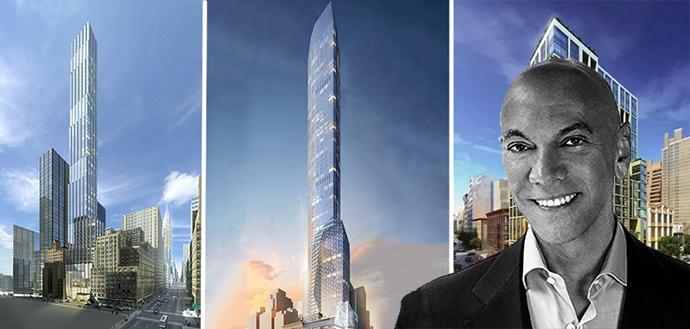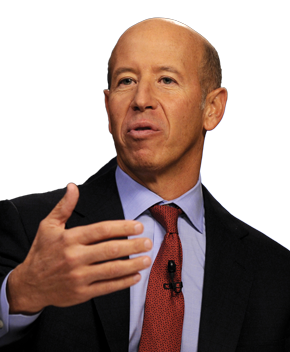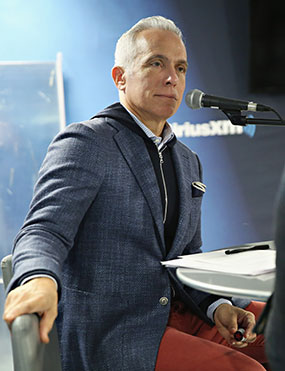Trending
The reinvention artist: How Lou Ceruzzi catapulted into the Manhattan condo game
Developer’s sudden death cuts short an unusual career

Lou Ceruzzi was only getting started. At 64, an age when many wealthy men are scouting retirement nests on the South Florida waterfront, he was overseeing the construction of his first Manhattan high-rises. After decades spent building a fortune in suburban retail, he was beginning to make a mark where it mattered most to him – the flashy world of New York luxury real estate.
But Ceruzzi couldn’t cement the legacy he craved. His sudden death of a “coronary event” Thursday put an end to that. His developments may well get built and succeed — the company’s executives insist they will — but they now carry the air of tragic unfulfillment.
Like many before him who fancied building for the elite, it wasn’t just lucre that drew Ceruzzi in.
“He viewed that as being, if you will, the big leagues,” said Art Hooper, who serves as Ceruzzi Properties’ general counsel and knew the developer for close to 30 years.
Jeffrey Dunne, a Connecticut-based investment sales broker at CBRE who worked with Ceruzzi for decades, recalled that Ceruzzi had a chance to make a fat profit on a Midtown East development site he bought from Gary Barnett in 2013. But he rejected the bid.
“I said, ‘Lou why don’t you sell it to him’?” Dunne recalled. “And he said, ‘I’ll never be recognized as a player in New York if I’m just flipping properties’.”
“Having a name, I think he thinks brings opportunity,” Dunne added. “The Rudins, the Fishers the Dursts — the deals come to them because they’re so well recognized. Ceruzzi is not one of those names.”
The developer was on course to change that. At the Midtown East site, at 138 East 50th Street, Ceruzzi teamed up with frequent partner SMI USA to develop a 72-story, 124-unit condo tower. In August, they scored a $300 million construction loan. At 520 Fifth Avenue, Ceruzzi and SMI are developing a 71-story hotel and condo tower. At 151 East 86th Street, Ceruzzi and Kuafu Properties are developing an 18-story, 61-unit condo on a site they bought in 2014 (a year after buying a leasehold on a neighboring parcel). Few developers have more luxury units in the works. And to top it all off, Ceruzzi and SMI bought the land under the famed Lipstick Building for $453 million in February 2016.
Dunne and Hooper, along with several other sources, spoke to The Real Deal in the weeks prior to Ceruzzi’s death for a planned profile of the developer. His death caught friends and colleagues by surprise — he was known to be in excellent physical shape — a tragic final twist to a career that was far from linear.
“I lost a very dear friend – a one of a kind shining star,” said Geoffrey Zakarian, the celebrity chef who partnered with Ceruzzi on restaurants. Town Residential’s Andrew Heiberger called him “a great man and a great talent.” His former development partner Frank Kenny of Willett Companies bemoaned a “big loss to the real estate industry in New York and Connecticut.”
Roy Stillman, Ceruzzi’s former partner at 151 East 86th Street (he still holds a small stake), said Ceruzzi had a “brilliant financial mind.”
“In a flattering way, he took advantage of life,” he added.
The baron of Big Box
A graduate of Georgetown and NYU Law School, Ceruzzi started off as a real estate tax attorney in New Haven. He didn’t stay a lawyer for long, noting, as he told the Commercial Observer in 2015, “the difference in the remuneration” between lawyers and their developer clients. In the late 1980s, he moved into development, building suburban retail properties.
I’ll never be recognized as a player in New York if I’m just flipping properties.
It was a time when big-box retailers like Walmart and Costco were expanding across the country and needed local partners to build stores. Ceruzzi proved adept at building relationships with these firms and his portfolio grew.
“He was able to engender a sense of confidence in [retail executives],” Hooper said. “Many developers in this country would kill to have a personal relationship with the chairman of Costco,” he added, referring to Jeff Brotman, who died just a few weeks before Ceruzzi.
Like many of his ilk, Ceruzzi struggled in the early 1990s, defaulting on some of his loans. But the retail juggernaut he had hitched his wagon to kept charging ahead, which meant he was never in serious trouble, sources said. His big break came in 1997. Barry Sternlicht’s Starwood Capital wanted to bet on retail real estate and was looking for a joint-venture partner with the contacts and know-how. Sternlicht and Ceruzzi teamed up and formed an entity called Starwood-Ceruzzi, which leveraged Starwood’s deep pockets to build a shopping-center empire in the Northeast.

Barry Sternlicht
“He had relationships with the retailers and he seemed to be a local sharpshooter,” Sternlicht recalled. “And he had this effervescent personality, a candid, jovial style. We just kind of liked him.” In 2005, Starwood sold its share in 11 properties to Inland Western for $430 million. Ceruzzi, however, retained his stake.
As the market began to recover from the financial crisis, suburban retail suddenly lost its sheen.
“There were seismic changes in the suburban retail business as a result of the 2008 recession and a large part of the business that we had engaged in from 1990 through 2008 had shrunk considerably,” Ceruzzi told TRD over email two weeks before his death.
Between 2006 and 2012, the company sold $531.6 million worth of properties, according to Real Capital Analytics data. Ceruzzi said he “felt that we were then capitalized to a degree that would allow us to do larger New York projects.” Meanwhile Manhattan’s condo market was roaring, and developers were being seen as rock stars, adopting the swagger and lifestyle to match.
“You go where the business is,” said Ed Blumenfeld, a developer who has partnered with Ceruzzi on projects and regularly met him for lunch.
To realize his Manhattan vision, Ceruzzi needed a new Starwood. He found SMI USA, the U.S. arm of Shanghai Municipal Investment, Shanghai’s largest state-owned enterprise and the developer of the world’s second-tallest skyscraper, the Shanghai Tower. Christopher Peck, a capital markets broker at HFF who arranged financing for several of Ceruzzi’s New York projects, said SMI held talks with many New York developers as it looked to enter the market around three years ago and was taken with Ceruzzi.
The first site Ceruzzi invested in, at 138 East 50th Street, was originally conceived as a hotel development by his Austrian partner Immovate. When SMI bought a stake in the project, replacing Immovate, it pushed for a switch to condos, Peck said.
The transition
Ceruzzi’s death leaves the three developments he was shepherding cloaked in uncertainty. SMI remains as the key equity player, and Stillman and Kuafu are capable partners on East 86th Street. For now, a management committee of Hooper, Kenneth Cartelli, Travis Farina and Robert Skolnick will head the firm.
“He was smart enough to build an infrastructure that can run the business without him,” Peck said. In a statement, Ceruzzi Properties said it “intends on continuing all of its development projects and commitments without interruption.” But there is no doubt that Ceruzzi was a driving force behind the projects and that his death leaves a void.
A sudden demise can also create complications for contracts and loan documents containing so-called “key-man provisions” that require a developer’s personal involvement. But a source familiar with Ceruzzi’s financing arrangements said they can usually be solved. While contracts differ wildly, the source said that another executive can usually be tapped as “key man” or as replacement developer.
“There’s absolutely going to be some bumps in the road,” Stillman said, but added that Ceruzzi Properties’ leadership “wants to fulfill Lou’s aspirations on his behalf.”
What adds another layer of complexity is the health of the luxury condo market. At 520 Fifth Avenue, where Ceruzzi and SMI paid Thor Equities $275 million for the land alone at the height of the condo craze in 2015, his cost basis isn’t exactly low. His debt likely isn’t cheap either. A $200 million bridge loan he landed in July from private debt fund manager Mack Real Estate Credit Strategies has an interest rate in the high single digits, according to sources, and covers about 50 percent of the project’s value. His construction lender at 138 East 50th Street is Madison Realty Capital and at 151 East 86th Street, his lender is the British hedge fund Children’s Investment Fund — both firms have a reputation for high-yield loans.
Lou was a dreamer. He knew no bounds.
Donna Olshan, who authors a popular weekly report on the luxury market, said any mistake is bound to prove costly at a time when buyers have more choices than ever.
“This isn’t a market anymore where you can just throw a dart against the wall and make money,” she said.
“Unfortunately, we have no ability to time the market, so we are building the projects that we purchased,” Ceruzzi wrote in the email to TRD. “We are making every effort to make certain that our developments contain the highest degree of finishes and amenities. We are certain that our product, coupled with our locations, will be very favorably received by the marketplace.”
It’s possible that Ceruzzi Properties will end up on the winner’s podium. Hooper argued that the 86th Street project (the only one the firm is building without SMI) is targeted to local families, which could make it less dependent on the fickle checkbooks of foreign buyers. Ceruzzi was also betting that two to three years from now, when the projects hit the market, the supply-and-demand balance will be more in a developer’s favor.
“Now is exactly the time that you should build,” Peck said. “The projects that were most successful, like Walker Tower, were built at the bottom of the market.”
Gabby Warshawer, head of research at CityRealty, said there “aren’t as many plans in the work for ‘regular’ luxury properties as there were, say, five years ago. So there should be less competition at those price points in two to three years, which would auger well for sales in the Ceruzzi developments.” The developer has yet to submit pricing details to the New York Attorney General’s office.
At the Lipstick Building, the rent on the leasehold, held by Argentinian real estate firm Inversiones y Representaciones Sociedad Anónima (IRSA), is set to escalate sharply in the coming years, which would be a big windfall for Ceruzzi Properties. But IRSA also has an option to buy the land for $520 million in 2020, and Ceruzzi said in the email that he has had “several conversations with IRSA, and IRSA has confirmed that they intend to purchase the property under the option at $520 [million] in 2020.”

Geoffrey Zakarian (credit: Getty)
La dolce vita
Ceruzzi was also an investor in several restaurants with Zakarian. One of these ventures got him into a spat with President Trump.
Ceruzzi and Zakarian had signed a deal for a restaurant at Trump International Hotel Washington, D.C. (which opened in October 2016.) In mid-2015, amid the controversy of Trump describing some Mexican immigrants as rapists, the two decided to pull out of the project. Trump sued them for $10 million. They settled in April.
“We went in. We signed what we thought was a very fortuitous deal for us and were going to open a great restaurant there,” Zakarian said of the deal. “Shit hit the fan, we pulled out, and that’s it.”
Ceruzzi loved the finer things. Zakarian described him as a true food and wine enthusiast. “There’s no bullshit with him,” he said, “which is so refreshing.” The developer had two go-to tailors in Italy, and traveled frequently. It didn’t always need to be a long-distance trip: Dunne recalled that after closing on a deal in White Plains earlier this year, Ceruzzi loaded all involved into a plane and flew them to Nantucket for dinner. They were back in New York the same night.
“Lou was a dreamer. He knew no bounds,” Sternlicht said. “He was incredibly ambitious and always wanted to move on to the next, ever bigger thing. Someone once told me ‘be careful where you set your goals because you may achieve them.’ Lou set very high goals and in life he just kept going forward.”




